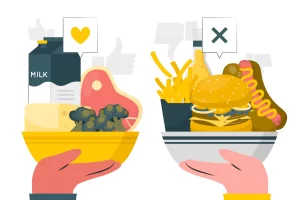 When it comes to fats, there’s often a misconception that all fats are bad for our health. However, not all fats are created equal. Understanding the difference between healthy and unhealthy fats is crucial for making informed dietary choices.
When it comes to fats, there’s often a misconception that all fats are bad for our health. However, not all fats are created equal. Understanding the difference between healthy and unhealthy fats is crucial for making informed dietary choices.
Today, we’ll delve into the contrasting characteristics of these two types of fats, helping you make smarter decisions about the fats you consume.
Healthy Fats
Healthy fats, also known as unsaturated fats, are an essential part of a balanced diet. They provide numerous health benefits and primarily come from plant sources such as nuts, seeds, avocados, and olives. We can further classify healthy fats into two subtypes:
- Monounsaturated fats. Monounsaturated fats, found in olive oil, canola oil, and avocados, are liquid at room temperature. They promote improved heart health by reducing bad cholesterol levels (LDL) and increasing good cholesterol levels (HDL). Incorporating monounsaturated fats into your diet can help protect against heart disease and lower the risk of stroke.
- Polyunsaturated fats. Polyunsaturated fats, present in fatty fish, flaxseeds, walnuts, and sunflower oil, are also liquid at room temperature. They are rich in omega-3 and omega-6 fatty acids, which are crucial for brain function and play a role in reducing inflammation in the body. Including polyunsaturated fats in your diet may help lower the risk of heart disease, promote brain health, and support overall well-being.
Unhealthy Fats
Unhealthy fats, namely saturated fats and trans fats, should be consumed in moderation due to their detrimental effects on health. They are primarily found in animal-based products and processed foods. Let’s take a closer look at each type:
- Saturated fats. Saturated fats exist in a solid state at room temperature and can be found in fatty cuts of meat, butter, cheese, and coconut oil. High consumption of saturated fats has been associated with increased levels of LDL cholesterol, which contributes to heart disease and other cardiovascular problems. To maintain heart health, it is advisable to limit the intake of saturated fats and opt for healthier alternatives.
- Trans fats. These fats are artificially produced through a process called hydrogenation, which transforms liquid oils into solid fats. Trans fats are commonly found in commercially baked goods, fried foods, and packaged snacks. They not only raise LDL cholesterol levels but also lower HDL cholesterol levels, posing a significant risk to cardiovascular health. Minimizing trans fat intake is crucial to reducing the risk of heart disease and related complications.
In the quest for a healthy lifestyle, understanding the difference between healthy and unhealthy fats is vital. By making conscious choices and opting for healthier fat sources, we can promote our long-term health and well-being.
Picture Credit: Freepik
